Exploring Social Media Impact on Global Branding: Malaysia
VerifiedAdded on 2022/08/28
|64
|14686
|15
Thesis and Dissertation
AI Summary
This dissertation investigates the impact of social media on enhancing the global branding of Malaysian companies. It explores the evolution of social media and its importance for businesses to connect with international customers and gain a competitive advantage. The research utilizes positivism philosophy, a deductive approach, a descriptive design, and a survey research strategy, collecting primary data from 70 employees across different Malaysian companies. Data analysis involves correlation and regression analysis to determine the relationship between social media use and global branding. The findings indicate a strong, positive correlation between social media and global branding, emphasizing the role of social media in improving brand awareness, trust, and recognition. The research concludes with recommendations for enhancing global branding using social media and identifies areas for future study.
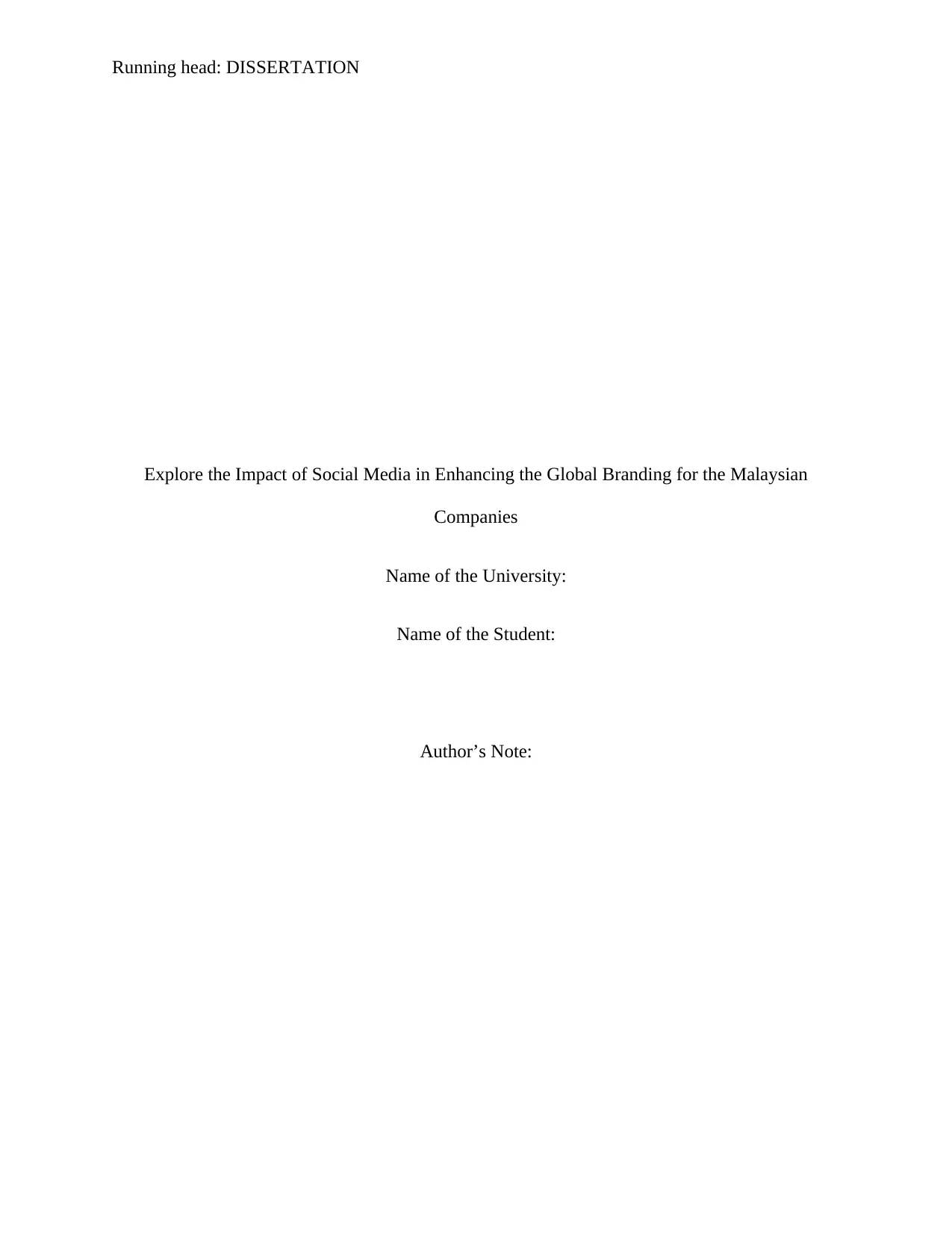
Running head: DISSERTATION
Explore the Impact of Social Media in Enhancing the Global Branding for the Malaysian
Companies
Name of the University:
Name of the Student:
Author’s Note:
Explore the Impact of Social Media in Enhancing the Global Branding for the Malaysian
Companies
Name of the University:
Name of the Student:
Author’s Note:
Paraphrase This Document
Need a fresh take? Get an instant paraphrase of this document with our AI Paraphraser
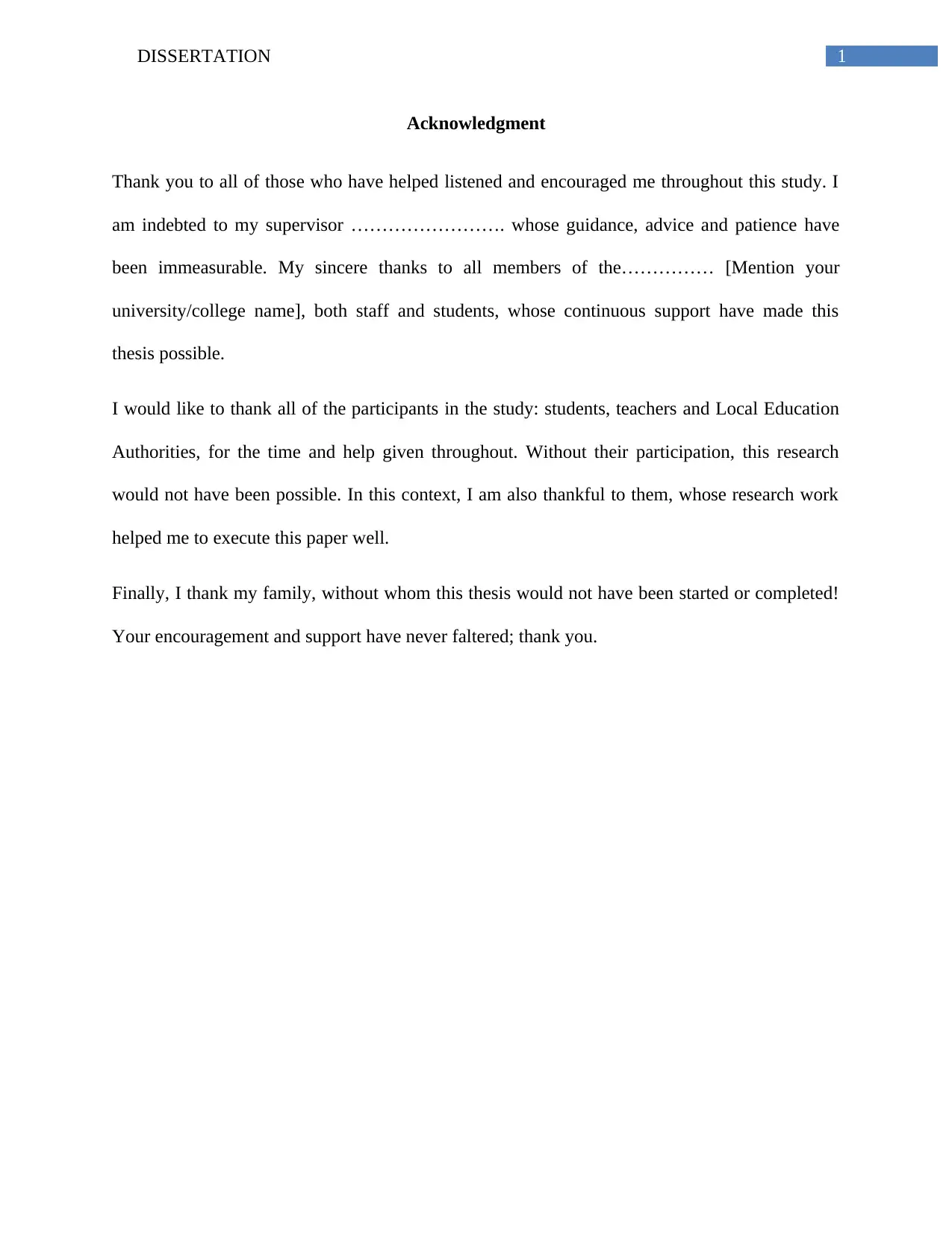
1DISSERTATION
Acknowledgment
Thank you to all of those who have helped listened and encouraged me throughout this study. I
am indebted to my supervisor ……………………. whose guidance, advice and patience have
been immeasurable. My sincere thanks to all members of the…………… [Mention your
university/college name], both staff and students, whose continuous support have made this
thesis possible.
I would like to thank all of the participants in the study: students, teachers and Local Education
Authorities, for the time and help given throughout. Without their participation, this research
would not have been possible. In this context, I am also thankful to them, whose research work
helped me to execute this paper well.
Finally, I thank my family, without whom this thesis would not have been started or completed!
Your encouragement and support have never faltered; thank you.
Acknowledgment
Thank you to all of those who have helped listened and encouraged me throughout this study. I
am indebted to my supervisor ……………………. whose guidance, advice and patience have
been immeasurable. My sincere thanks to all members of the…………… [Mention your
university/college name], both staff and students, whose continuous support have made this
thesis possible.
I would like to thank all of the participants in the study: students, teachers and Local Education
Authorities, for the time and help given throughout. Without their participation, this research
would not have been possible. In this context, I am also thankful to them, whose research work
helped me to execute this paper well.
Finally, I thank my family, without whom this thesis would not have been started or completed!
Your encouragement and support have never faltered; thank you.
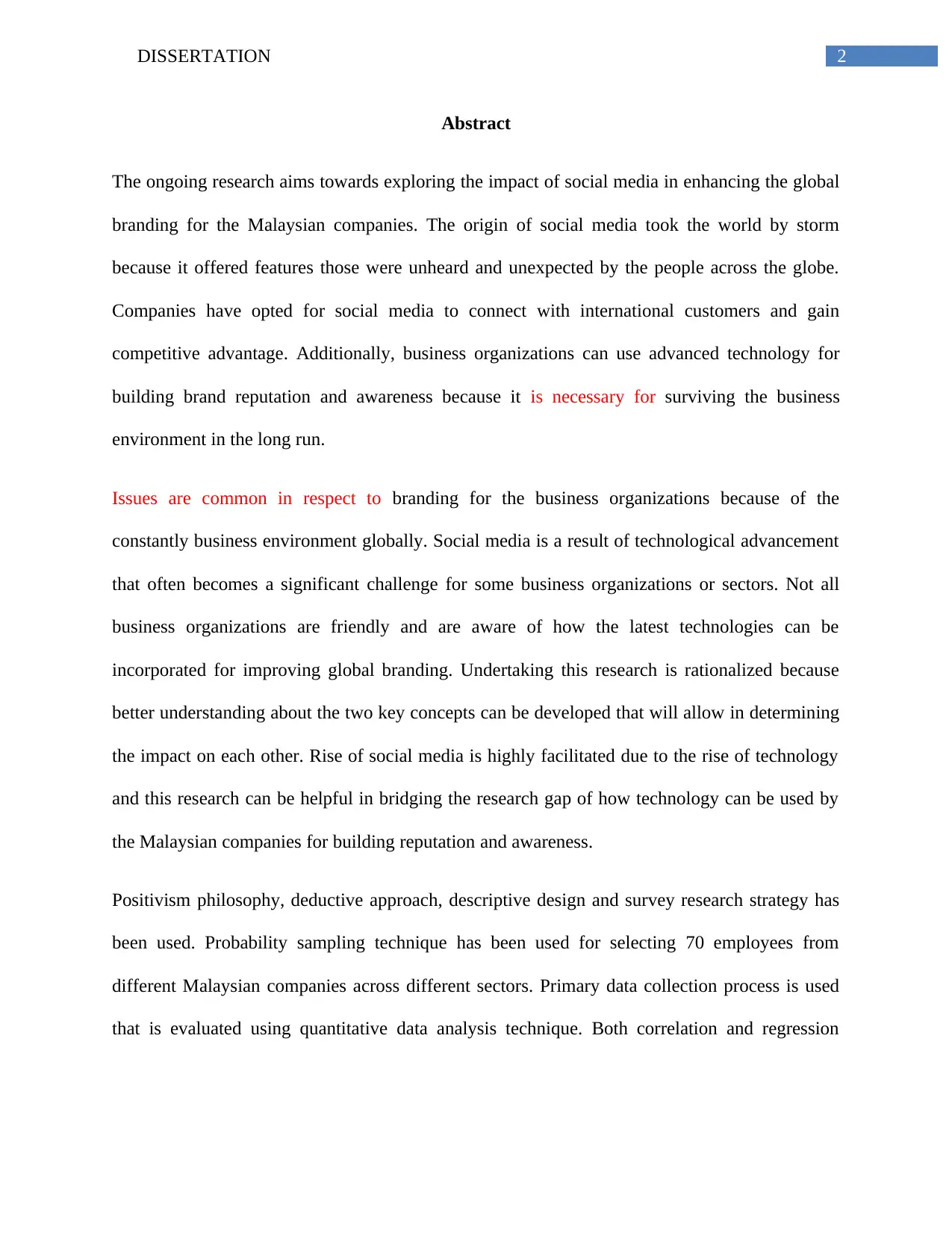
2DISSERTATION
Abstract
The ongoing research aims towards exploring the impact of social media in enhancing the global
branding for the Malaysian companies. The origin of social media took the world by storm
because it offered features those were unheard and unexpected by the people across the globe.
Companies have opted for social media to connect with international customers and gain
competitive advantage. Additionally, business organizations can use advanced technology for
building brand reputation and awareness because it is necessary for surviving the business
environment in the long run.
Issues are common in respect to branding for the business organizations because of the
constantly business environment globally. Social media is a result of technological advancement
that often becomes a significant challenge for some business organizations or sectors. Not all
business organizations are friendly and are aware of how the latest technologies can be
incorporated for improving global branding. Undertaking this research is rationalized because
better understanding about the two key concepts can be developed that will allow in determining
the impact on each other. Rise of social media is highly facilitated due to the rise of technology
and this research can be helpful in bridging the research gap of how technology can be used by
the Malaysian companies for building reputation and awareness.
Positivism philosophy, deductive approach, descriptive design and survey research strategy has
been used. Probability sampling technique has been used for selecting 70 employees from
different Malaysian companies across different sectors. Primary data collection process is used
that is evaluated using quantitative data analysis technique. Both correlation and regression
Abstract
The ongoing research aims towards exploring the impact of social media in enhancing the global
branding for the Malaysian companies. The origin of social media took the world by storm
because it offered features those were unheard and unexpected by the people across the globe.
Companies have opted for social media to connect with international customers and gain
competitive advantage. Additionally, business organizations can use advanced technology for
building brand reputation and awareness because it is necessary for surviving the business
environment in the long run.
Issues are common in respect to branding for the business organizations because of the
constantly business environment globally. Social media is a result of technological advancement
that often becomes a significant challenge for some business organizations or sectors. Not all
business organizations are friendly and are aware of how the latest technologies can be
incorporated for improving global branding. Undertaking this research is rationalized because
better understanding about the two key concepts can be developed that will allow in determining
the impact on each other. Rise of social media is highly facilitated due to the rise of technology
and this research can be helpful in bridging the research gap of how technology can be used by
the Malaysian companies for building reputation and awareness.
Positivism philosophy, deductive approach, descriptive design and survey research strategy has
been used. Probability sampling technique has been used for selecting 70 employees from
different Malaysian companies across different sectors. Primary data collection process is used
that is evaluated using quantitative data analysis technique. Both correlation and regression
⊘ This is a preview!⊘
Do you want full access?
Subscribe today to unlock all pages.

Trusted by 1+ million students worldwide
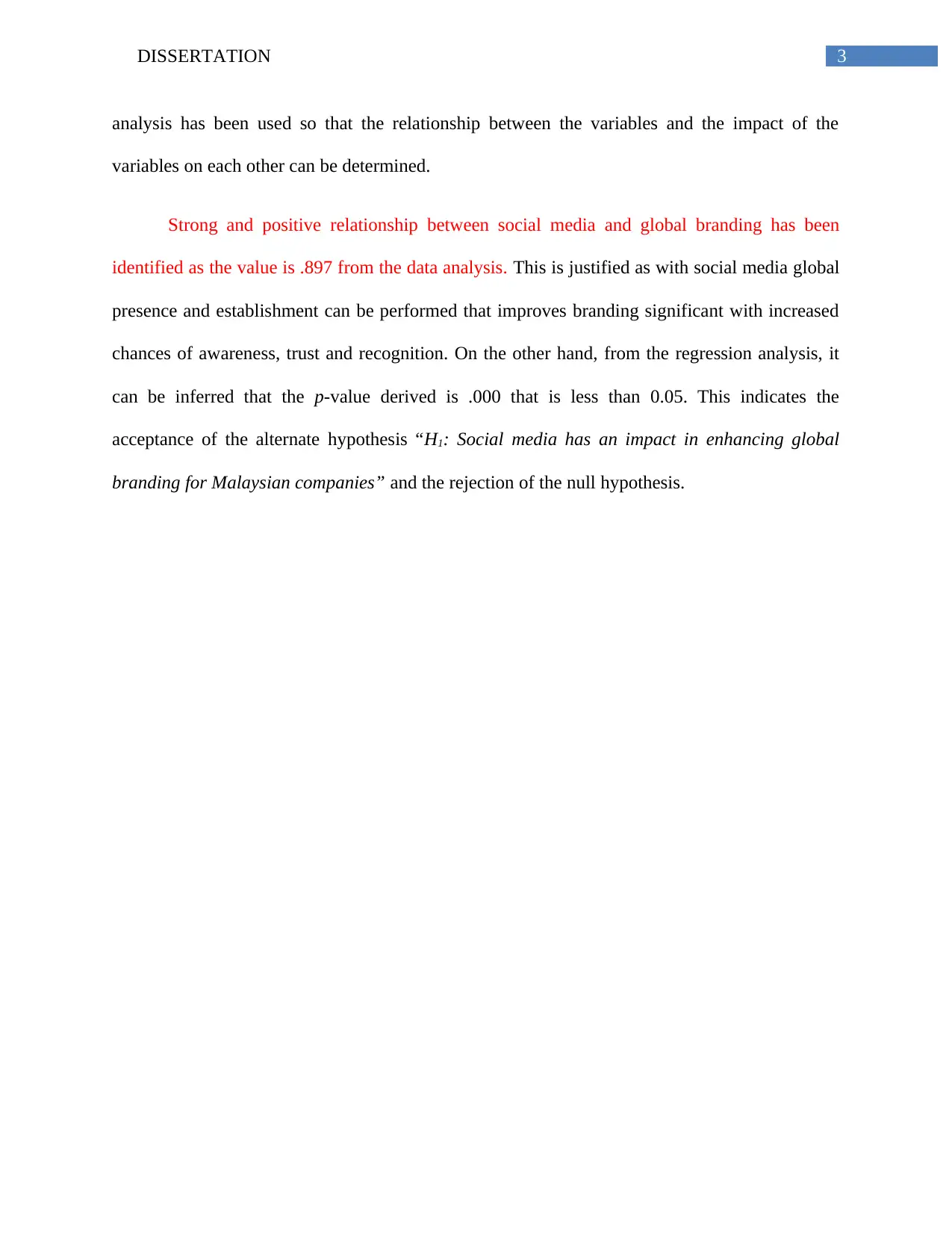
3DISSERTATION
analysis has been used so that the relationship between the variables and the impact of the
variables on each other can be determined.
Strong and positive relationship between social media and global branding has been
identified as the value is .897 from the data analysis. This is justified as with social media global
presence and establishment can be performed that improves branding significant with increased
chances of awareness, trust and recognition. On the other hand, from the regression analysis, it
can be inferred that the p-value derived is .000 that is less than 0.05. This indicates the
acceptance of the alternate hypothesis “H1: Social media has an impact in enhancing global
branding for Malaysian companies” and the rejection of the null hypothesis.
analysis has been used so that the relationship between the variables and the impact of the
variables on each other can be determined.
Strong and positive relationship between social media and global branding has been
identified as the value is .897 from the data analysis. This is justified as with social media global
presence and establishment can be performed that improves branding significant with increased
chances of awareness, trust and recognition. On the other hand, from the regression analysis, it
can be inferred that the p-value derived is .000 that is less than 0.05. This indicates the
acceptance of the alternate hypothesis “H1: Social media has an impact in enhancing global
branding for Malaysian companies” and the rejection of the null hypothesis.
Paraphrase This Document
Need a fresh take? Get an instant paraphrase of this document with our AI Paraphraser
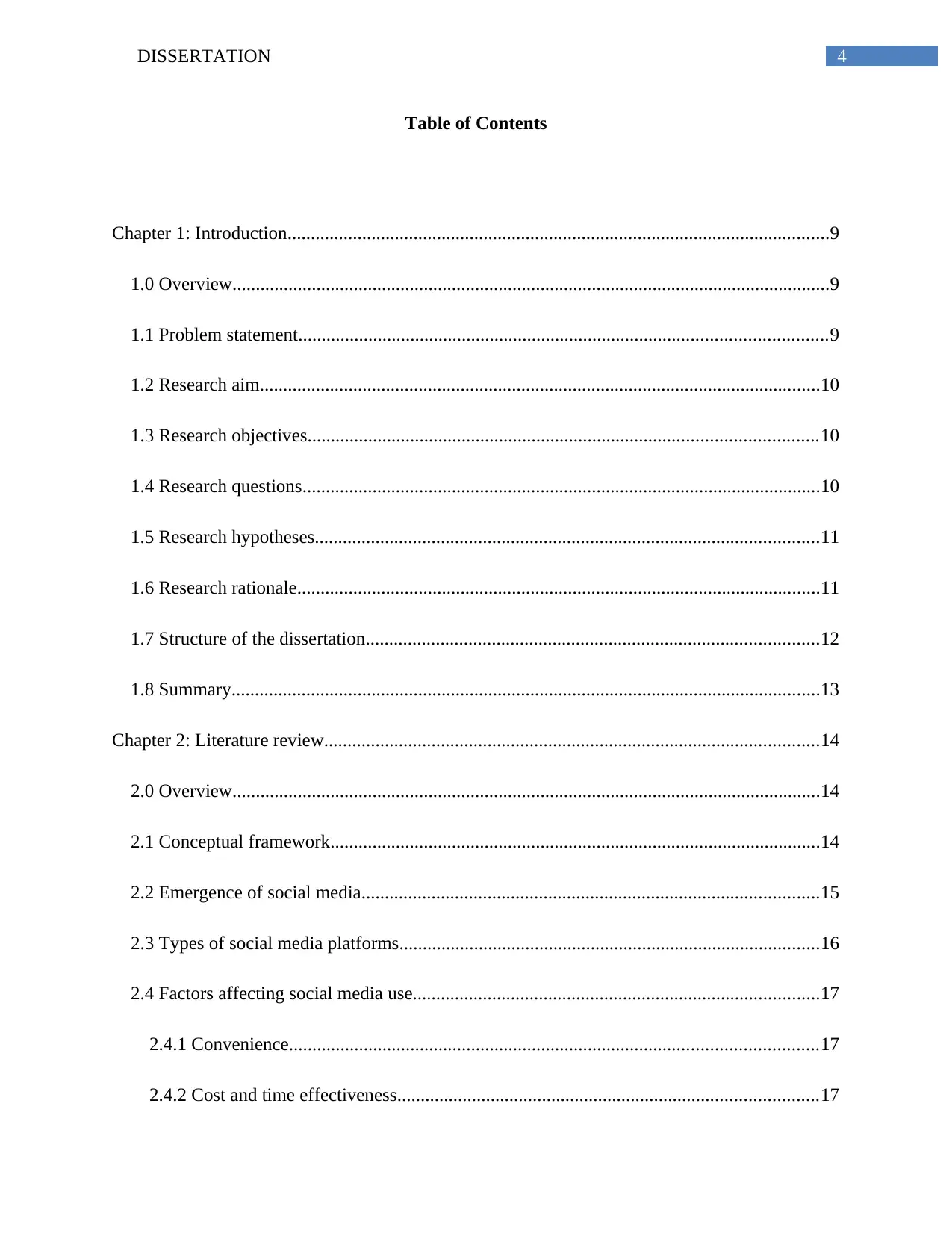
4DISSERTATION
Table of Contents
Chapter 1: Introduction....................................................................................................................9
1.0 Overview................................................................................................................................9
1.1 Problem statement.................................................................................................................9
1.2 Research aim........................................................................................................................10
1.3 Research objectives.............................................................................................................10
1.4 Research questions...............................................................................................................10
1.5 Research hypotheses............................................................................................................11
1.6 Research rationale................................................................................................................11
1.7 Structure of the dissertation.................................................................................................12
1.8 Summary..............................................................................................................................13
Chapter 2: Literature review..........................................................................................................14
2.0 Overview..............................................................................................................................14
2.1 Conceptual framework.........................................................................................................14
2.2 Emergence of social media..................................................................................................15
2.3 Types of social media platforms..........................................................................................16
2.4 Factors affecting social media use.......................................................................................17
2.4.1 Convenience.................................................................................................................17
2.4.2 Cost and time effectiveness..........................................................................................17
Table of Contents
Chapter 1: Introduction....................................................................................................................9
1.0 Overview................................................................................................................................9
1.1 Problem statement.................................................................................................................9
1.2 Research aim........................................................................................................................10
1.3 Research objectives.............................................................................................................10
1.4 Research questions...............................................................................................................10
1.5 Research hypotheses............................................................................................................11
1.6 Research rationale................................................................................................................11
1.7 Structure of the dissertation.................................................................................................12
1.8 Summary..............................................................................................................................13
Chapter 2: Literature review..........................................................................................................14
2.0 Overview..............................................................................................................................14
2.1 Conceptual framework.........................................................................................................14
2.2 Emergence of social media..................................................................................................15
2.3 Types of social media platforms..........................................................................................16
2.4 Factors affecting social media use.......................................................................................17
2.4.1 Convenience.................................................................................................................17
2.4.2 Cost and time effectiveness..........................................................................................17
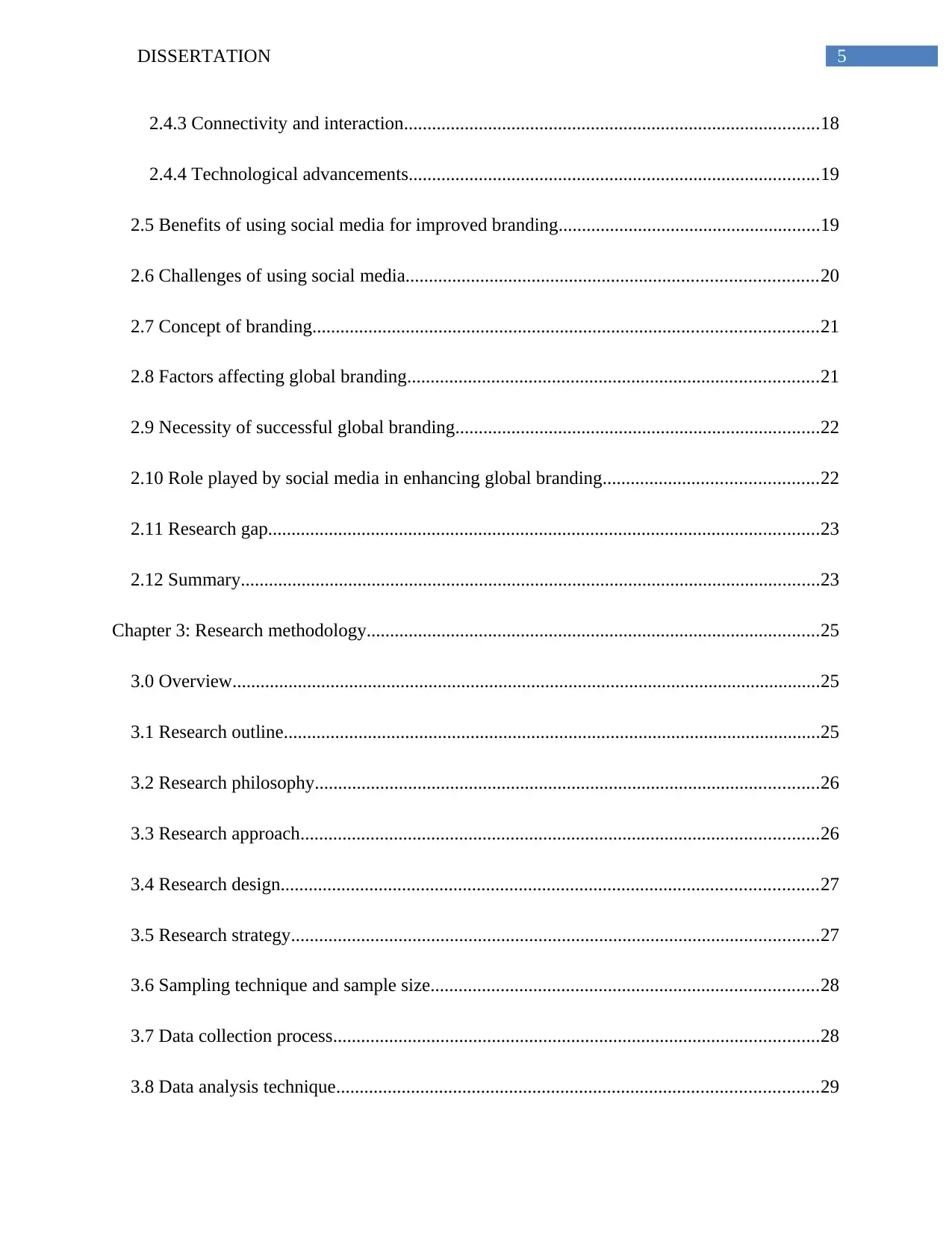
5DISSERTATION
2.4.3 Connectivity and interaction.........................................................................................18
2.4.4 Technological advancements........................................................................................19
2.5 Benefits of using social media for improved branding........................................................19
2.6 Challenges of using social media........................................................................................20
2.7 Concept of branding............................................................................................................21
2.8 Factors affecting global branding........................................................................................21
2.9 Necessity of successful global branding..............................................................................22
2.10 Role played by social media in enhancing global branding..............................................22
2.11 Research gap......................................................................................................................23
2.12 Summary............................................................................................................................23
Chapter 3: Research methodology.................................................................................................25
3.0 Overview..............................................................................................................................25
3.1 Research outline...................................................................................................................25
3.2 Research philosophy............................................................................................................26
3.3 Research approach...............................................................................................................26
3.4 Research design...................................................................................................................27
3.5 Research strategy.................................................................................................................27
3.6 Sampling technique and sample size...................................................................................28
3.7 Data collection process........................................................................................................28
3.8 Data analysis technique.......................................................................................................29
2.4.3 Connectivity and interaction.........................................................................................18
2.4.4 Technological advancements........................................................................................19
2.5 Benefits of using social media for improved branding........................................................19
2.6 Challenges of using social media........................................................................................20
2.7 Concept of branding............................................................................................................21
2.8 Factors affecting global branding........................................................................................21
2.9 Necessity of successful global branding..............................................................................22
2.10 Role played by social media in enhancing global branding..............................................22
2.11 Research gap......................................................................................................................23
2.12 Summary............................................................................................................................23
Chapter 3: Research methodology.................................................................................................25
3.0 Overview..............................................................................................................................25
3.1 Research outline...................................................................................................................25
3.2 Research philosophy............................................................................................................26
3.3 Research approach...............................................................................................................26
3.4 Research design...................................................................................................................27
3.5 Research strategy.................................................................................................................27
3.6 Sampling technique and sample size...................................................................................28
3.7 Data collection process........................................................................................................28
3.8 Data analysis technique.......................................................................................................29
⊘ This is a preview!⊘
Do you want full access?
Subscribe today to unlock all pages.

Trusted by 1+ million students worldwide
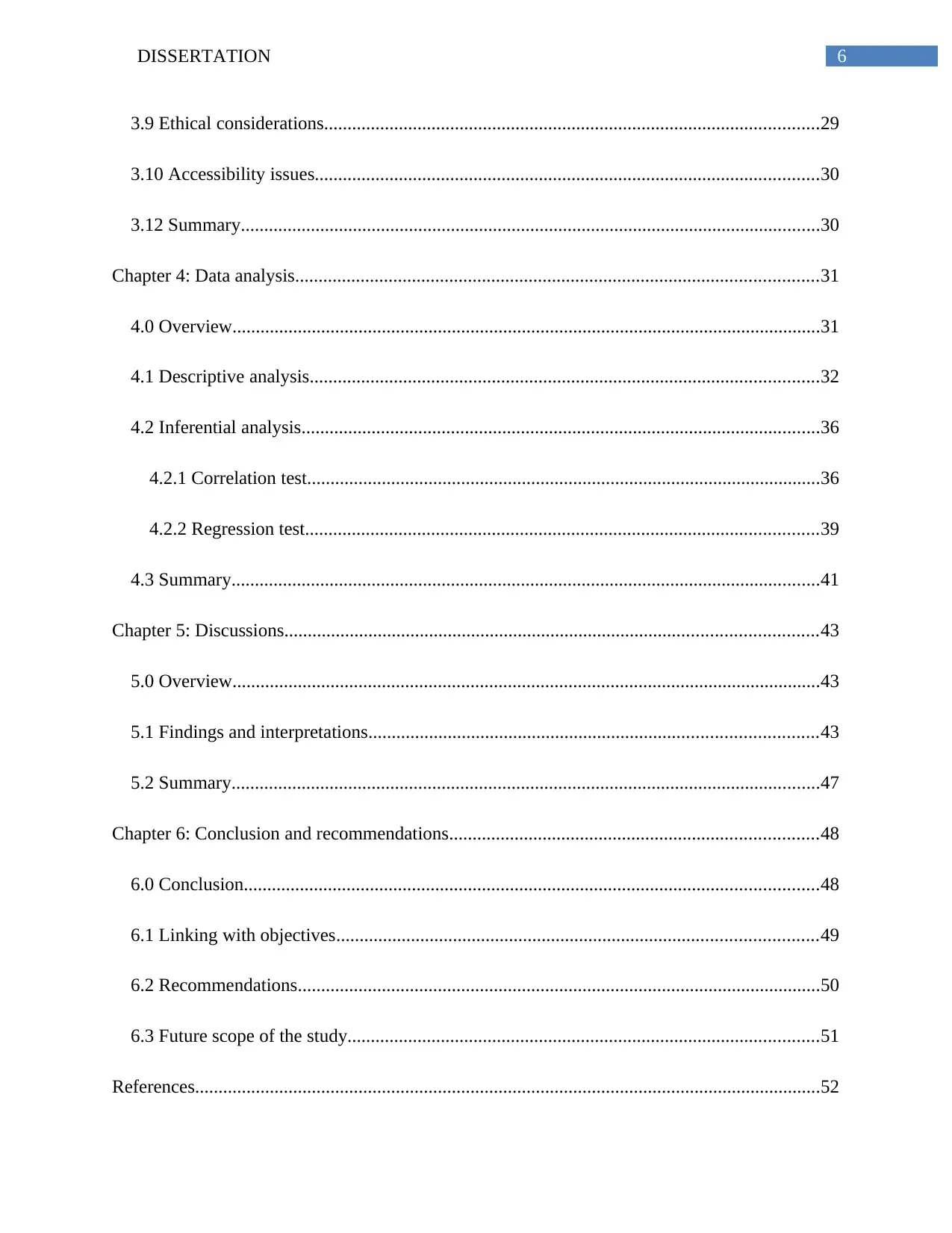
6DISSERTATION
3.9 Ethical considerations..........................................................................................................29
3.10 Accessibility issues............................................................................................................30
3.12 Summary............................................................................................................................30
Chapter 4: Data analysis................................................................................................................31
4.0 Overview..............................................................................................................................31
4.1 Descriptive analysis.............................................................................................................32
4.2 Inferential analysis...............................................................................................................36
4.2.1 Correlation test..............................................................................................................36
4.2.2 Regression test..............................................................................................................39
4.3 Summary..............................................................................................................................41
Chapter 5: Discussions..................................................................................................................43
5.0 Overview..............................................................................................................................43
5.1 Findings and interpretations................................................................................................43
5.2 Summary..............................................................................................................................47
Chapter 6: Conclusion and recommendations...............................................................................48
6.0 Conclusion...........................................................................................................................48
6.1 Linking with objectives.......................................................................................................49
6.2 Recommendations................................................................................................................50
6.3 Future scope of the study.....................................................................................................51
References......................................................................................................................................52
3.9 Ethical considerations..........................................................................................................29
3.10 Accessibility issues............................................................................................................30
3.12 Summary............................................................................................................................30
Chapter 4: Data analysis................................................................................................................31
4.0 Overview..............................................................................................................................31
4.1 Descriptive analysis.............................................................................................................32
4.2 Inferential analysis...............................................................................................................36
4.2.1 Correlation test..............................................................................................................36
4.2.2 Regression test..............................................................................................................39
4.3 Summary..............................................................................................................................41
Chapter 5: Discussions..................................................................................................................43
5.0 Overview..............................................................................................................................43
5.1 Findings and interpretations................................................................................................43
5.2 Summary..............................................................................................................................47
Chapter 6: Conclusion and recommendations...............................................................................48
6.0 Conclusion...........................................................................................................................48
6.1 Linking with objectives.......................................................................................................49
6.2 Recommendations................................................................................................................50
6.3 Future scope of the study.....................................................................................................51
References......................................................................................................................................52
Paraphrase This Document
Need a fresh take? Get an instant paraphrase of this document with our AI Paraphraser
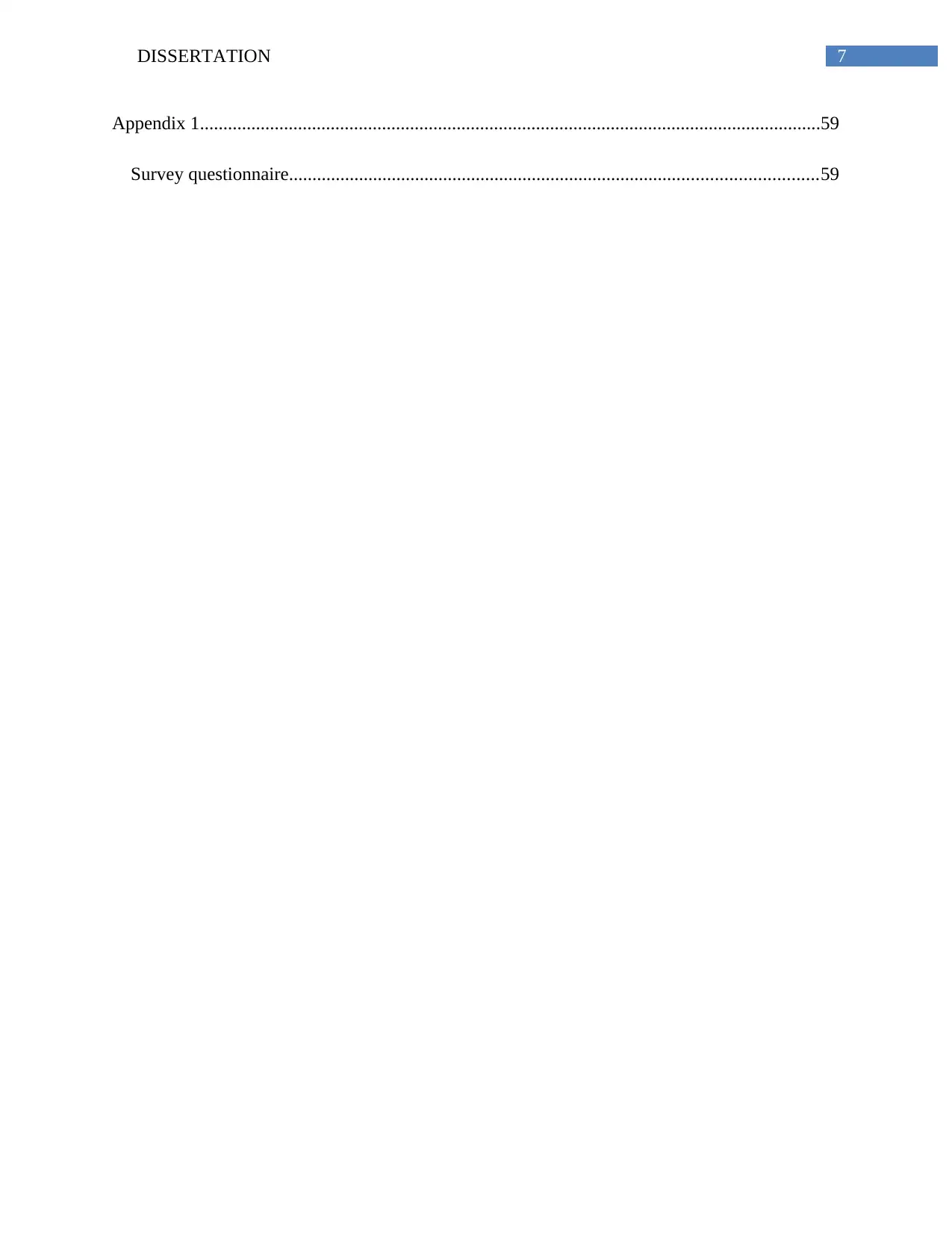
7DISSERTATION
Appendix 1.....................................................................................................................................59
Survey questionnaire.................................................................................................................59
Appendix 1.....................................................................................................................................59
Survey questionnaire.................................................................................................................59
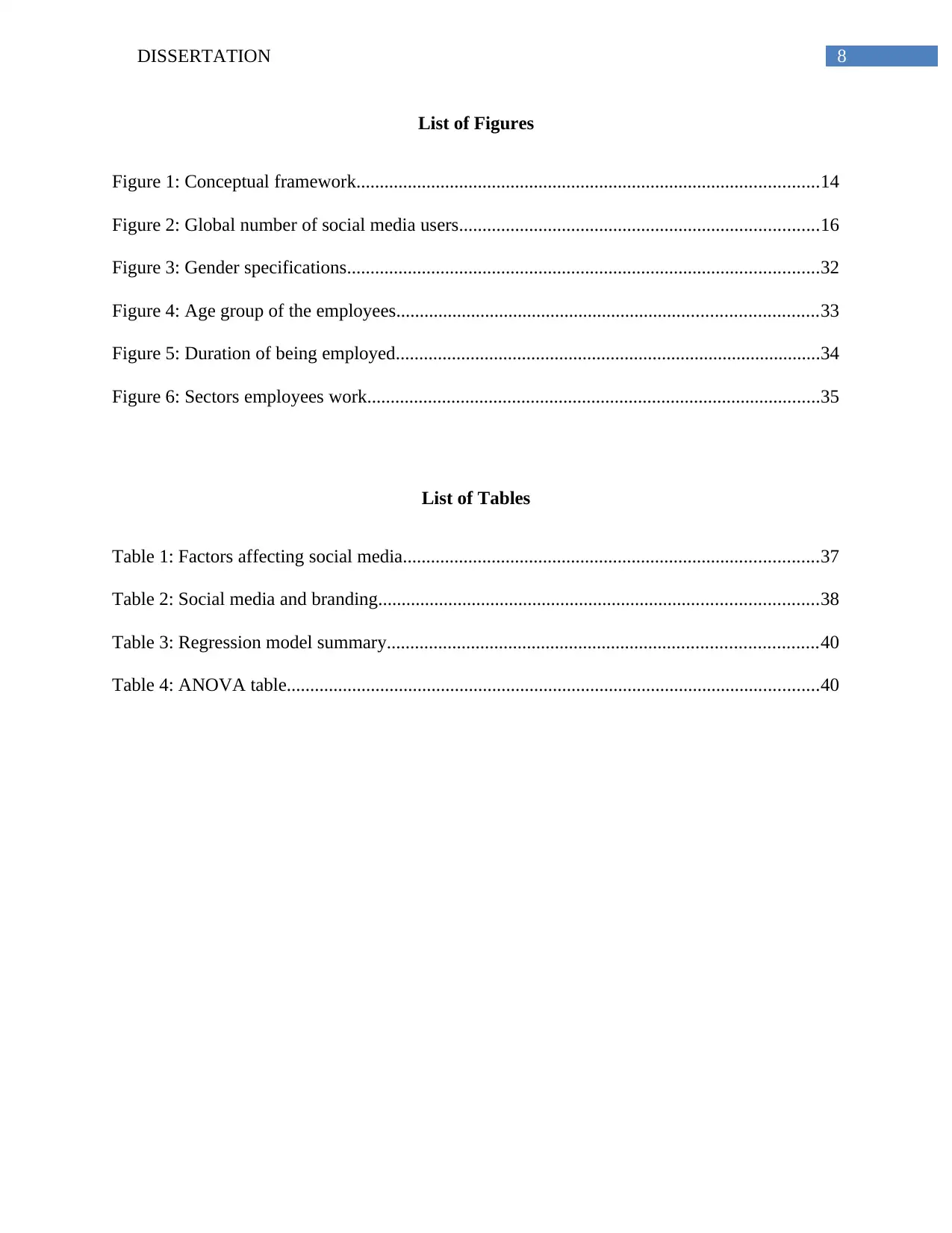
8DISSERTATION
List of Figures
Figure 1: Conceptual framework...................................................................................................14
Figure 2: Global number of social media users.............................................................................16
Figure 3: Gender specifications.....................................................................................................32
Figure 4: Age group of the employees..........................................................................................33
Figure 5: Duration of being employed...........................................................................................34
Figure 6: Sectors employees work.................................................................................................35
List of Tables
Table 1: Factors affecting social media.........................................................................................37
Table 2: Social media and branding..............................................................................................38
Table 3: Regression model summary............................................................................................40
Table 4: ANOVA table..................................................................................................................40
List of Figures
Figure 1: Conceptual framework...................................................................................................14
Figure 2: Global number of social media users.............................................................................16
Figure 3: Gender specifications.....................................................................................................32
Figure 4: Age group of the employees..........................................................................................33
Figure 5: Duration of being employed...........................................................................................34
Figure 6: Sectors employees work.................................................................................................35
List of Tables
Table 1: Factors affecting social media.........................................................................................37
Table 2: Social media and branding..............................................................................................38
Table 3: Regression model summary............................................................................................40
Table 4: ANOVA table..................................................................................................................40
⊘ This is a preview!⊘
Do you want full access?
Subscribe today to unlock all pages.

Trusted by 1+ million students worldwide
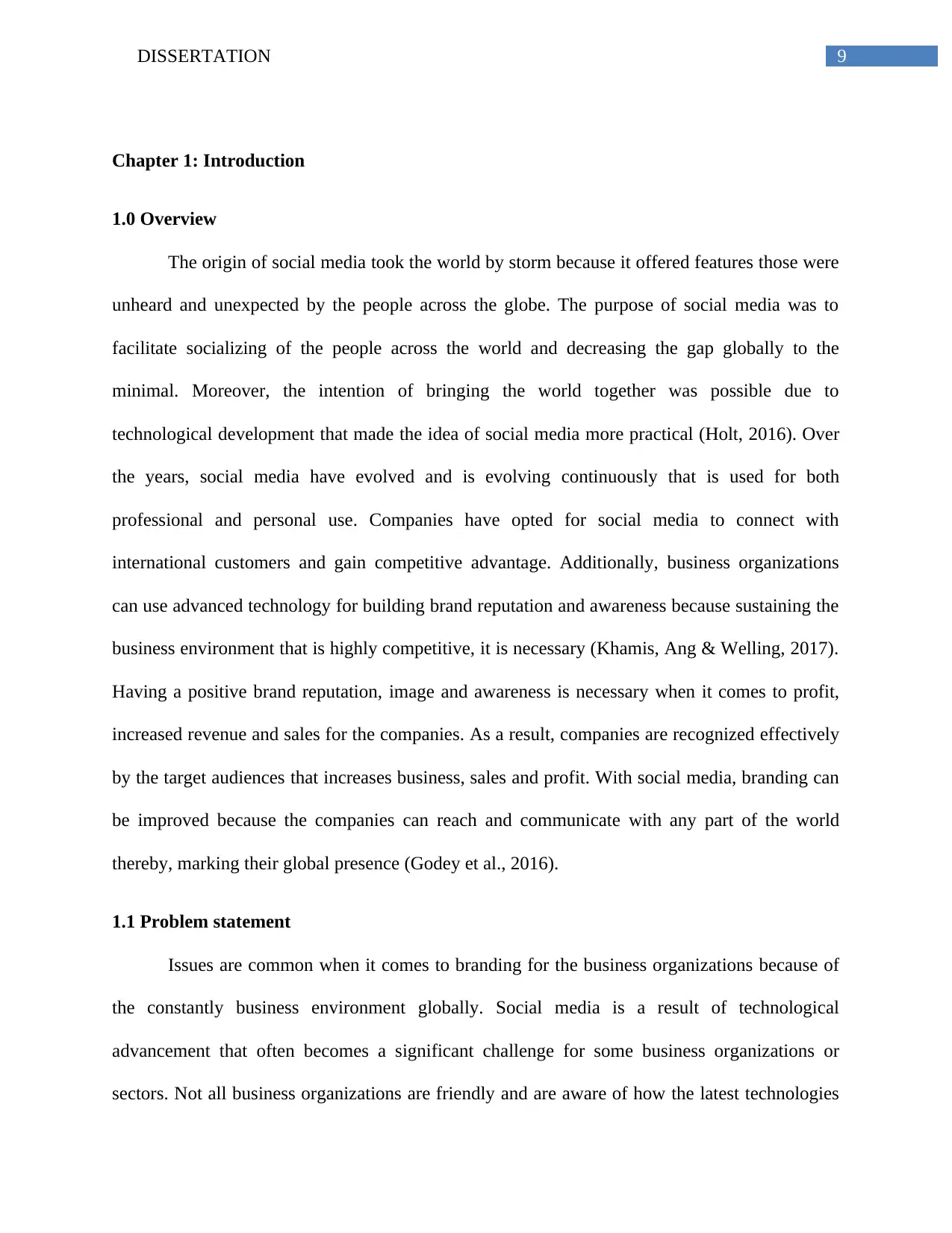
9DISSERTATION
Chapter 1: Introduction
1.0 Overview
The origin of social media took the world by storm because it offered features those were
unheard and unexpected by the people across the globe. The purpose of social media was to
facilitate socializing of the people across the world and decreasing the gap globally to the
minimal. Moreover, the intention of bringing the world together was possible due to
technological development that made the idea of social media more practical (Holt, 2016). Over
the years, social media have evolved and is evolving continuously that is used for both
professional and personal use. Companies have opted for social media to connect with
international customers and gain competitive advantage. Additionally, business organizations
can use advanced technology for building brand reputation and awareness because sustaining the
business environment that is highly competitive, it is necessary (Khamis, Ang & Welling, 2017).
Having a positive brand reputation, image and awareness is necessary when it comes to profit,
increased revenue and sales for the companies. As a result, companies are recognized effectively
by the target audiences that increases business, sales and profit. With social media, branding can
be improved because the companies can reach and communicate with any part of the world
thereby, marking their global presence (Godey et al., 2016).
1.1 Problem statement
Issues are common when it comes to branding for the business organizations because of
the constantly business environment globally. Social media is a result of technological
advancement that often becomes a significant challenge for some business organizations or
sectors. Not all business organizations are friendly and are aware of how the latest technologies
Chapter 1: Introduction
1.0 Overview
The origin of social media took the world by storm because it offered features those were
unheard and unexpected by the people across the globe. The purpose of social media was to
facilitate socializing of the people across the world and decreasing the gap globally to the
minimal. Moreover, the intention of bringing the world together was possible due to
technological development that made the idea of social media more practical (Holt, 2016). Over
the years, social media have evolved and is evolving continuously that is used for both
professional and personal use. Companies have opted for social media to connect with
international customers and gain competitive advantage. Additionally, business organizations
can use advanced technology for building brand reputation and awareness because sustaining the
business environment that is highly competitive, it is necessary (Khamis, Ang & Welling, 2017).
Having a positive brand reputation, image and awareness is necessary when it comes to profit,
increased revenue and sales for the companies. As a result, companies are recognized effectively
by the target audiences that increases business, sales and profit. With social media, branding can
be improved because the companies can reach and communicate with any part of the world
thereby, marking their global presence (Godey et al., 2016).
1.1 Problem statement
Issues are common when it comes to branding for the business organizations because of
the constantly business environment globally. Social media is a result of technological
advancement that often becomes a significant challenge for some business organizations or
sectors. Not all business organizations are friendly and are aware of how the latest technologies
Paraphrase This Document
Need a fresh take? Get an instant paraphrase of this document with our AI Paraphraser
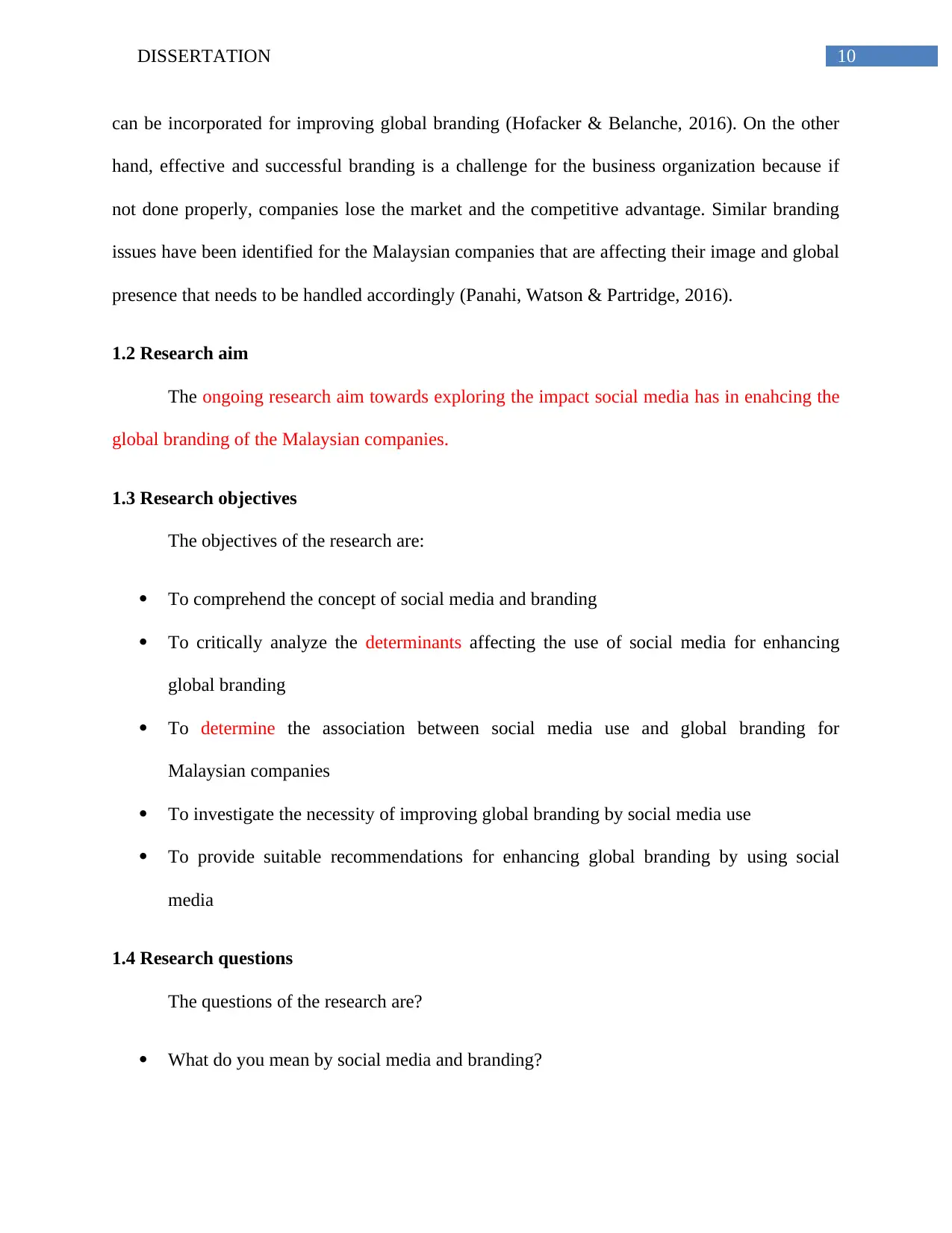
10DISSERTATION
can be incorporated for improving global branding (Hofacker & Belanche, 2016). On the other
hand, effective and successful branding is a challenge for the business organization because if
not done properly, companies lose the market and the competitive advantage. Similar branding
issues have been identified for the Malaysian companies that are affecting their image and global
presence that needs to be handled accordingly (Panahi, Watson & Partridge, 2016).
1.2 Research aim
The ongoing research aim towards exploring the impact social media has in enahcing the
global branding of the Malaysian companies.
1.3 Research objectives
The objectives of the research are:
To comprehend the concept of social media and branding
To critically analyze the determinants affecting the use of social media for enhancing
global branding
To determine the association between social media use and global branding for
Malaysian companies
To investigate the necessity of improving global branding by social media use
To provide suitable recommendations for enhancing global branding by using social
media
1.4 Research questions
The questions of the research are?
What do you mean by social media and branding?
can be incorporated for improving global branding (Hofacker & Belanche, 2016). On the other
hand, effective and successful branding is a challenge for the business organization because if
not done properly, companies lose the market and the competitive advantage. Similar branding
issues have been identified for the Malaysian companies that are affecting their image and global
presence that needs to be handled accordingly (Panahi, Watson & Partridge, 2016).
1.2 Research aim
The ongoing research aim towards exploring the impact social media has in enahcing the
global branding of the Malaysian companies.
1.3 Research objectives
The objectives of the research are:
To comprehend the concept of social media and branding
To critically analyze the determinants affecting the use of social media for enhancing
global branding
To determine the association between social media use and global branding for
Malaysian companies
To investigate the necessity of improving global branding by social media use
To provide suitable recommendations for enhancing global branding by using social
media
1.4 Research questions
The questions of the research are?
What do you mean by social media and branding?
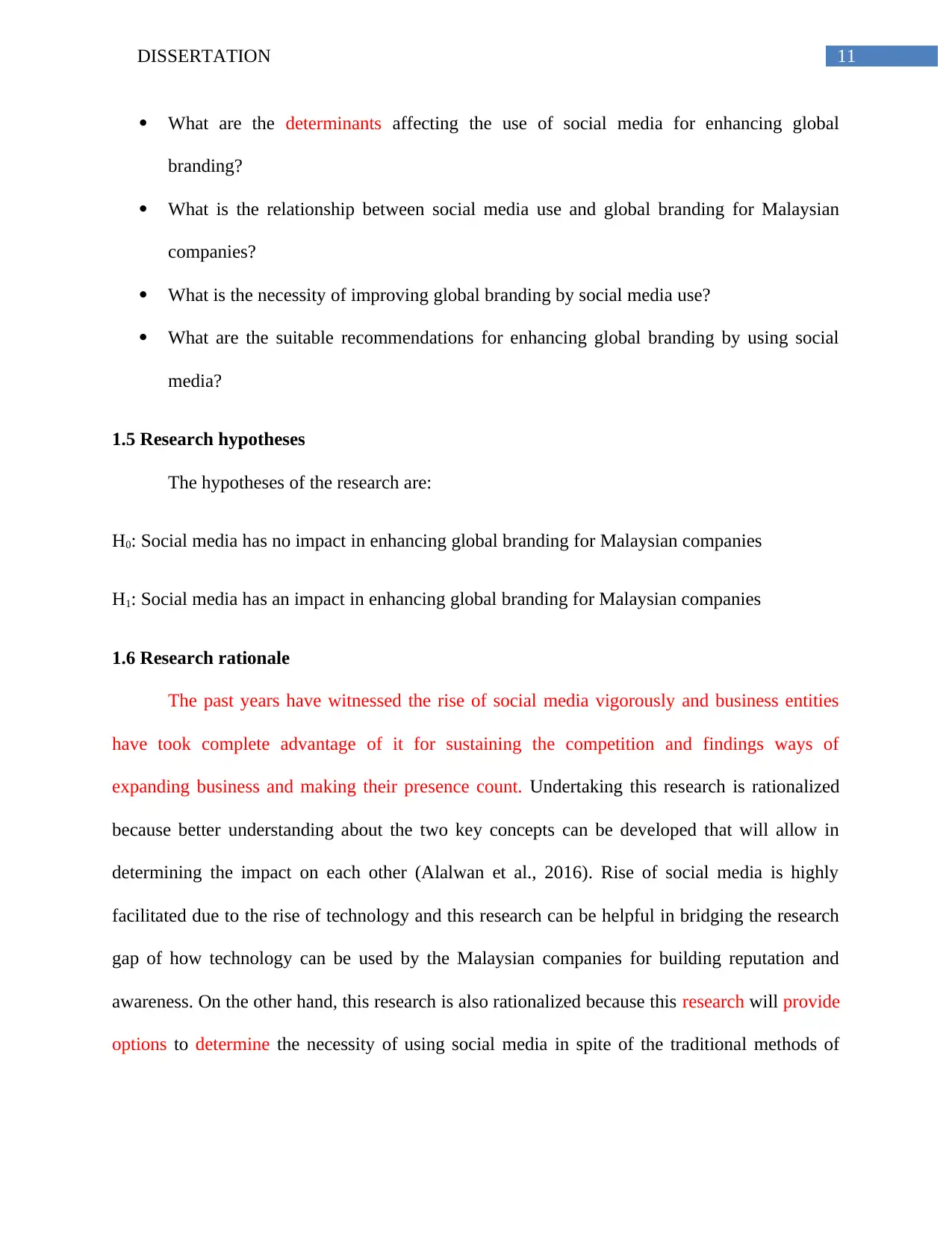
11DISSERTATION
What are the determinants affecting the use of social media for enhancing global
branding?
What is the relationship between social media use and global branding for Malaysian
companies?
What is the necessity of improving global branding by social media use?
What are the suitable recommendations for enhancing global branding by using social
media?
1.5 Research hypotheses
The hypotheses of the research are:
H0: Social media has no impact in enhancing global branding for Malaysian companies
H1: Social media has an impact in enhancing global branding for Malaysian companies
1.6 Research rationale
The past years have witnessed the rise of social media vigorously and business entities
have took complete advantage of it for sustaining the competition and findings ways of
expanding business and making their presence count. Undertaking this research is rationalized
because better understanding about the two key concepts can be developed that will allow in
determining the impact on each other (Alalwan et al., 2016). Rise of social media is highly
facilitated due to the rise of technology and this research can be helpful in bridging the research
gap of how technology can be used by the Malaysian companies for building reputation and
awareness. On the other hand, this research is also rationalized because this research will provide
options to determine the necessity of using social media in spite of the traditional methods of
What are the determinants affecting the use of social media for enhancing global
branding?
What is the relationship between social media use and global branding for Malaysian
companies?
What is the necessity of improving global branding by social media use?
What are the suitable recommendations for enhancing global branding by using social
media?
1.5 Research hypotheses
The hypotheses of the research are:
H0: Social media has no impact in enhancing global branding for Malaysian companies
H1: Social media has an impact in enhancing global branding for Malaysian companies
1.6 Research rationale
The past years have witnessed the rise of social media vigorously and business entities
have took complete advantage of it for sustaining the competition and findings ways of
expanding business and making their presence count. Undertaking this research is rationalized
because better understanding about the two key concepts can be developed that will allow in
determining the impact on each other (Alalwan et al., 2016). Rise of social media is highly
facilitated due to the rise of technology and this research can be helpful in bridging the research
gap of how technology can be used by the Malaysian companies for building reputation and
awareness. On the other hand, this research is also rationalized because this research will provide
options to determine the necessity of using social media in spite of the traditional methods of
⊘ This is a preview!⊘
Do you want full access?
Subscribe today to unlock all pages.

Trusted by 1+ million students worldwide
1 out of 64
Related Documents
Your All-in-One AI-Powered Toolkit for Academic Success.
+13062052269
info@desklib.com
Available 24*7 on WhatsApp / Email
![[object Object]](/_next/static/media/star-bottom.7253800d.svg)
Unlock your academic potential
Copyright © 2020–2025 A2Z Services. All Rights Reserved. Developed and managed by ZUCOL.





